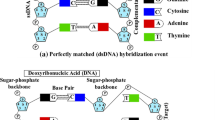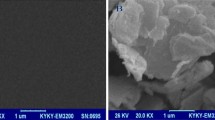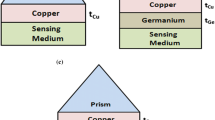Abstract
As detection of specific deoxyribonucleic acid (DNA) sequences is of great importance in diagnosing many fatal and genetic diseases, there have been renewed interests in designing highly sensitive label-free DNA detection platforms. This paper presents a molybdenum diselenide (MoSe2)-graphene hybrid structure-based surface plasmon resonance (SPR) biosensor with capability of detecting single-nucleotide polymorphism (SNP) and DNA hybridization events. Because of its better absorption capability the MoSe2 layer provides strong excitation energy which induces huge charge carrier transfer while the graphene layer serves as a biomolecular recognition element to capture bio-analytes through π-stacking force. The silver (Ag) layer is attached to the BK7 prism by a very thin titanium (Ti) adhesion film which also serves as oxidization and corrosion protection layer. The biosensor is optimized by numerical modeling and the optimum structure has an excellent sensitivity of 215.5°/RIU which is better than other reported works. It has been demonstrated that when target DNAs are attached to the probe DNAs pre-immobilized on the sensing surface the change of SPR angle is insignificant for mismatched DNA strands while it is highly prominent for complementary DNA strands. Thus, the proposed sensor can effectively distinguish hybridization event and SNP by examining the level of changes in resonance angle and reflectance spectrum.










Similar content being viewed by others
Data availability
All data generated and/or analyzed during this study are available from the corresponding author on reasonable request.
References
J. Homola, M. Piliarik, Surf. Plasmon Reson. (SPR) Sens. 4, 45–67 (2006). https://doi.org/10.1007/5346_014
J. Homola, S.S. Yee, G. Gauglitz, Surface plasmon resonance sensors: review. Sens. Actuators, B Chem. 54(1), 3–15 (1999). https://doi.org/10.1016/S0925-4005(98)00321-9
J. Homola, Present and future of surface plasmon resonance biosensors. Anal. Bioanal. Chem. 377(3), 528–539 (2003). https://doi.org/10.1007/s00216-003-2101-0
J. Majka, C. Speck, Analysis of protein-DNA interactions using surface plasmon resonance. Adv. Biochem. Eng. Biotechnol. 104, 13–36 (2006). https://doi.org/10.1007/10_026
F. Wei, P.B. Lillehoj, C.M. Ho, DNA diagnostics: nanotechnology-enhanced electrochemical detection of nucleic acids. Pediatr. Res. 67(5), 458–468 (2010). https://doi.org/10.1203/PDR.0b013e3181d361c3
C. Te Lin et al., Label-free electrical detection of DNA hybridization on graphene using Hall effect measurements: revisiting the sensing mechanism. Adv. Funct. Mater. 23(18), 2301–2307 (2013). https://doi.org/10.1002/adfm.201202672
H.H. Nguyen, J. Park, S. Kang, M. Kim, Surface plasmon resonance: a versatile technique for biosensor applications. Sensors (Switzerland) 15(5), 10481–10510 (2015). https://doi.org/10.3390/s150510481
A.V. Kabashin et al., Plasmonic nanorod metamaterials for biosensing. Nat. Mater. 8(11), 867–871 (2009). https://doi.org/10.1038/nmat2546
L. Guo, J.A. Jackman, H.H. Yang, P. Chen, N.J. Cho, D.H. Kim, Strategies for enhancing the sensitivity of plasmonic nanosensors. Nano Today 10(2), 213–239 (2015). https://doi.org/10.1016/j.nantod.2015.02.007
A. Shalabney, I. Abdulhalim, Sensitivity-enhancement methods for surface plasmon sensors. Laser Photonics Rev. 5(4), 571–606 (2011). https://doi.org/10.1002/lpor.201000009
L. Wu, H.S. Chu, W.S. Koh, E.P. Li, Highly sensitive graphene biosensors based on surface plasmon resonance. Opt. Expr. 18(14), 14395 (2010). https://doi.org/10.1364/oe.18.014395
S.H. Choi, Y.L. Kim, K.M. Byun, Graphene-on-silver substrates for sensitive surface plasmon resonance imaging biosensors. Opt. Expr. 19(2), 458 (2011). https://doi.org/10.1364/oe.19.000458
X. Dong, Y. Shi, W. Huang, P. Chen, L.J. Li, Electrical detection of DNA hybridization with single-base specificity using transistors based on CVD-grown graphene sheets. Adv. Mater. 22(14), 1649–1653 (2010). https://doi.org/10.1002/adma.200903645
P.T.K. Loan, W. Zhang, C. Te Lin, K.H. Wei, L.J. Li, C.H. Chen, Graphene/MoS2 heterostructures for ultrasensitive detection of DNA hybridisation. Adv. Mater. 26(28), 4838–4844 (2014). https://doi.org/10.1002/adma.201401084
Y.V. Morozov, M. Kuno, Optical constants and dynamic conductivities of single layer MoS2, MoSe2, and WSe2. Appl. Phys. Lett. (2015). https://doi.org/10.1063/1.4929700
Q. Ouyang et al., Two-dimensional transition metal dichalcogenide enhanced phase-sensitive plasmonic biosensors: theoretical insight. J. Phys. Chem. C 121(11), 6282–6289 (2017). https://doi.org/10.1021/acs.jpcc.6b12858
A.K. Mishra, S.K. Mishra, R.K. Verma, Graphene and beyond graphene MoS2: a new window in surface-plasmon-resonance-based fiber optic sensing. J. Phys. Chem. C 120(5), 2893–2900 (2016). https://doi.org/10.1021/acs.jpcc.5b08955
M.S. Rahman, M.S. Anower, M.R. Hasan, M.B. Hossain, M.I. Haque, Design and numerical analysis of highly sensitive Au–MoS2-graphene-based hybrid surface plasmon resonance biosensor. Opt. Commun. 396, 36–43 (2017). https://doi.org/10.1016/j.optcom.2017.03.035
L. Wu et al., Sensitivity improved SPR biosensor based on the MoS2/graphene-aluminum hybrid structure. J. Light. Technol. 35(1), 82–87 (2017). https://doi.org/10.1109/JLT.2016.2624982
J.B. Maurya, Y.K. Prajapati, A comparative study of different metal and prism in the surface plasmon resonance biosensor having MoS2-graphene. Opt. Quantum Electron (2016). https://doi.org/10.1007/s11082-016-0562-6
C. Zhu, Z. Zeng, H. Li, F. Li, C. Fan, H. Zhang, Single-layer MoS2-based nanoprobes for homogeneous detection of biomolecules. J. Am. Chem. Soc. 135(16), 5998–6001 (2013). https://doi.org/10.1021/ja4019572
M.B. Hossain, Numerical modeling of MoS2–graphene bilayer-based high-performance surface plasmon resonance sensor: structure optimization for DNA hybridization. Opt. Eng. (2020). https://doi.org/10.1117/1.oe.59.10.105105
B. Meshginqalam, J. Barvestani, Performance enhancement of SPR biosensor based on phosphorene and transition metal dichalcogenides for sensing DNA hybridization. IEEE Sens. J. 18(18), 7537–7543 (2018). https://doi.org/10.1109/JSEN.2018.2861829
S. Tongay et al., Broad-range modulation of light emission in two-dimensional semiconductors by molecular physisorption gating. Nano Lett. 13(6), 2831–2836 (2013). https://doi.org/10.1021/nl4011172
H. Chen et al., Manipulation of photoluminescence of two-dimensional MoSe2 by gold nanoantennas. Sci. Rep. (2016). https://doi.org/10.1038/srep22296
H.V. Han et al., Photoluminescence enhancement and structure repairing of monolayer MoSe2 by hydrohalic acid treatment. ACS Nano 10(1), 1454–1461 (2016). https://doi.org/10.1021/acsnano.5b06960
P. Tonndorf et al., Photoluminescence emission and Raman response of monolayer MoS_2, MoSe_2, and WSe_2. Opt. Expr. 21(4), 4908 (2013). https://doi.org/10.1364/oe.21.004908
H.J. Reich, R.J. Hondal, Why nature chose selenium. ACS Chem. Biol. 11(4), 821–841 (2016). https://doi.org/10.1021/acschembio.6b00031
Y. Luo et al., Sensitivity-enhanced surface plasmon sensor modified with MoSe2 overlayer. Opt. Expr. 26(26), 34250 (2018). https://doi.org/10.1364/oe.26.034250
K. Liu et al., MoSe2–Au based sensitivity enhanced optical fiber surface plasmon resonance biosensor for detection of goat-anti-rabbit IgG. IEEE Access (2020). https://doi.org/10.1109/ACCESS.2019.2961751
A.K. Sharma, B.D. Gupta, On the performance of different bimetallic combinations in surface plasmon resonance based fiber optic sensors. J. Appl. Phys (2007). https://doi.org/10.1063/1.2721779
S. Zeng et al., Graphene-MoS2 hybrid nanostructures enhanced surface plasmon resonance biosensors. Sens. Actuators, B Chem 207, 801–810 (2015). https://doi.org/10.1016/j.snb.2014.10.124
E. D. Palik, “Handbook of optical constants of solids,” in Academic Press, vol. 3, 1998
B.D. Gupta, A.K. Sharma, Sensitivity evaluation of a multi-layered surface plasmon resonance-based fiber optic sensor: a theoretical study. Sens. Actuators, B Chem. 107(1), 40–46 (2005). https://doi.org/10.1016/j.snb.2004.08.030
M. Bruna, S. Borini, “Optical constants of graphene layers in the visible range. Appl. Phys. Lett. (2009). https://doi.org/10.1063/1.3073717
J. Hölzl and F. K. Schulte, “Work function of metals,” in Solid surface physics, 1979, pp. 1–150
T. Shimada, F.S. Ohuchi, Work function and photothreshold of layered metal dichalcogenides. Jpn. J. Appl. Phys. 33(5R), 2696 (1994). https://doi.org/10.1143/JJAP.33.2696
S.M. Song, J.K. Park, O.J. Sul, B.J. Cho, Determination of work function of graphene under a metal electrode and its role in contact resistance. Nano Lett. 12(8), 3887–3892 (2012). https://doi.org/10.1021/nl300266p
L. Britnell et al., Strong light-matter interactions in heterostructures of atomically thin films. Science 340(6138), 1311–1314 (2013). https://doi.org/10.1126/science.1235547
C.H. Chen et al., A flexible hydrophilic-modified graphene microprobe for neural and cardiac recording. Nanomed. Nanotechnol. Biol. Med. 9(5), 600–604 (2013). https://doi.org/10.1016/j.nano.2012.12.004
H.L. Liu, C.C. Shen, S.H. Su, C.L. Hsu, M.Y. Li, L.J. Li, “Optical properties of monolayer transition metal dichalcogenides probed by spectroscopic ellipsometry. Appl. Phys. Lett. (2014). https://doi.org/10.1063/1.4901836
G.M. Hale, M.R. Querry, Optical constants of water in the 200-nm–200-μm wavelength region. Appl. Opt. 12(3), 555 (1973). https://doi.org/10.1364/ao.12.000555
Q. Ouyang et al., “Sensitivity enhancement of transition metal dichalcogenides/silicon nanostructure-based surface plasmon resonance biosensor. Sci. Rep. (2016). https://doi.org/10.1038/srep28190
P.K. Maharana, T. Srivastava, R. Jha, On the performance of highly sensitive and accurate graphene-on-aluminum and silicon-based SPR biosensor for visible and near infrared. Plasmonics 9(5), 1113–1120 (2014). https://doi.org/10.1007/s11468-014-9721-4
J.Q. Hu, X.H. Shi, S.Q. Wu, K.M. Ho, Z.Z. Zhu, “Dependence of electronic and optical properties of MoS2 multilayers on the interlayer coupling and van hove singularity. Nanoscale Res. Lett. (2019). https://doi.org/10.1186/s11671-019-3105-9
A. Kumara, P.K. Ahluwalia, Electronic structure of transition metal dichalcogenides monolayers 1H-MX2 (M = Mo, W; X = S, Se, Te) from ab-initio theory: new direct bandgap semiconductors. Eur. Phys. (2012). https://doi.org/10.1140/epjb/e2012-30070-x
L. Wu et al., Sensitivity enhancement by using few-layer black phosphorus-graphene/TMDCs heterostructure in surface plasmon resonance biochemical sensor. Sens. Actuators, B Chem. 249, 542–548 (2017). https://doi.org/10.1016/j.snb.2017.04.110
J. Qiao, X. Kong, Z.X. Hu, F. Yang, W. Ji, High-mobility transport anisotropy and linear dichroism in few-layer black phosphorus. Nat. Commun. (2014). https://doi.org/10.1038/ncomms5475
X.C. Yuan, B.H. Ong, Y.G. Tan, D.W. Zhang, R. Irawan, S.C. Tjin, Sensitivity-stability-optimized surface plasmon resonance sensing with double metal layers. J. Opt. A Pure Appl. Opt. 8(11), 959–963 (2006). https://doi.org/10.1088/1464-4258/8/11/005
P.K. Maharana, P. Padhy, R. Jha, On the field enhancement and performance of an ultra-stable SPR biosensor based on graphene. IEEE Photonics Technol. Lett. 25(22), 2156–2159 (2013). https://doi.org/10.1109/LPT.2013.2281453
S. Pal, A. Verma, S. Raikwar, Y.K. Prajapati, J.P. Saini, “Detection of DNA hybridization using graphene-coated black phosphorus surface plasmon resonance sensor. Appl. Phys. A Mater. Sci. Process. (2018). https://doi.org/10.1007/s00339-018-1804-1
A. Verma, A. Prakash, R. Tripathi, Performance analysis of graphene-based surface plasmon resonance biosensors for detection of pseudomonas-like bacteria. Opt. Quantum Electron. 47(5), 1197–1205 (2015). https://doi.org/10.1007/s11082-014-9976-1
D.T. Nurrohman, N.-F. Chiu, Surface plasmon resonance biosensor performance analysis on 2D material based on graphene and transition metal dichalcogenides. ECS J. Solid State Sci. Technol. 9(11), 115023 (2020). https://doi.org/10.1149/2162-8777/abb419
L. Diéauez, N. Darwish, M. Mir, E. Martínez, M. Moreno, J. Samitier, Effect of the refractive index of buffer solutions in evanescent optical biosensors. Sens. Lett. 7(5), 851–855 (2009). https://doi.org/10.1166/sl.2009.1161
V. Ball, J.J. Ramsden, Buffer dependence of refractive index increments of protein solutions. Biopolymers 46(7), 489–492 (1998). https://doi.org/10.1002/(SICI)1097-0282(199812)46:7%3c489::AID-BIP6%3e3.3.CO;2-5
H. Zhao, P.H. Brown, P. Schuck, On the distribution of protein refractive index increments. Biophys. J. 100(9), 2309–2317 (2011). https://doi.org/10.1016/j.bpj.2011.03.004
G.E. Perlmann, L.G. Longsworth, The specific refractive increment of some purified proteins. J. Am. Chem. Soc. 70(8), 2719–2724 (1948). https://doi.org/10.1021/ja01188a027
J.B. Maurya, Y.K. Prajapati, Experimental demonstration of DNA hybridization using graphene-based plasmonic sensor chip. J. Light. Technol. 38(18), 5191–5198 (2020). https://doi.org/10.1109/JLT.2020.2998138
Y. Huang et al., Development of a portable SPR sensor for nucleic acid detection. Micromachines (2020). https://doi.org/10.3390/mi11050526
S. Wang, Y. Zhang, Y. Ning, G.J. Zhang, A WS2 nanosheet-based platform for fluorescent DNA detection via PNA-DNA hybridization. Analyst 140(2), 434–439 (2015). https://doi.org/10.1039/c4an01738b
A.H. Loo, A. Bonanni, A. Ambrosi, M. Pumera, Molybdenum disulfide (MoS2) nanoflakes as inherently electroactive labels for DNA hybridization detection. Nanoscale 6(20), 11971–11975 (2014). https://doi.org/10.1039/c4nr03795b
N.H. Kim, M. Choi, T.W. Kim, W. Choi, S.Y. Park, K.M. Byun, Sensitivity and stability enhancement of surface plasmon resonance biosensors based on a large-area Ag/MoS2 substrate. Sensors (Switzerland) (2019). https://doi.org/10.3390/s19081894
Funding
No funding was received for conducting this study.
Author information
Authors and Affiliations
Contributions
TH: Conceptualization, methodology, validation, formal analysis, investigation, writing—original draft. HKR: Conceptualization, methodology, supervision, writing—review and editing.
Corresponding author
Ethics declarations
Conflict of interest
The authors declare that there is no conflict of interests regarding the publication of this paper.
Additional information
Publisher's Note
Springer Nature remains neutral with regard to jurisdictional claims in published maps and institutional affiliations.
Rights and permissions
About this article
Cite this article
Haque, T., Rouf, H.K. DNA hybridization detection using graphene-MoSe2–Ag heterostructure-based surface plasmon resonance biosensor. Appl. Phys. A 127, 759 (2021). https://doi.org/10.1007/s00339-021-04888-w
Received:
Accepted:
Published:
DOI: https://doi.org/10.1007/s00339-021-04888-w




